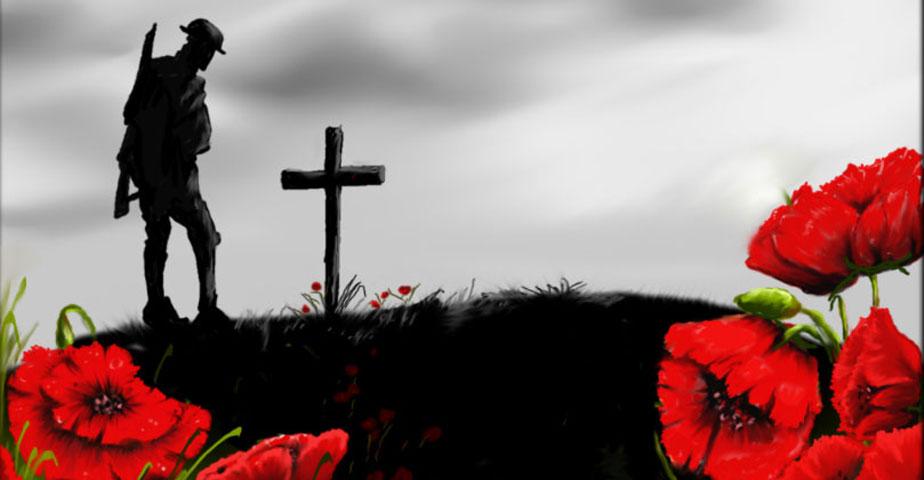Africa-Press – Lesotho. Whatever the numbers, we owe to those brave souls who engaged in the War our Freedoms and a duty of remembrance is certainly merited
When I was at primary school in the 1950s, every 11 November at the stroke of 11am we used to gather in the large playground to observe a two-minute silence.
Everyone, from the headmaster to the cleaner and all the pupils, sported a red paper poppy on their chest for the occasion. Chacha Deolall, who worked as attendant at the village hall, used to collect money for Poppy Day but lamented that very few people actually made a donation.
Lack of money aside, I think this was due to a total lack of knowledge of what the Poppy actually stood for. As a matter of fact Poppy Day — also known as Remembrance Day — is observed on 11 November in many Commonwealth countries (and elsewhere) to mark the end of the hostilities of World War I (1914-1918), also known as the Great War.
After five years of blood-letting — with seven million civilians and 10m military personnel killed — the signing of the Armistice between the Allies and Germany at the 11-hour on 11th-day of the 11th-month in 1918 at Compiegne in France signalled the end of fighting.
Symbol
The highly symbolic red poppy became the familiar emblem of Remembrance Day as a tribute to the poem ‘The Flanders Fields’, the name given to World War I (WWI) battlefields that straddled the large swathes of land from southern Belgium to north-west France.
The lament was penned in the midst of war by John McCrae, a Canadian army doctor who died in 1915 whilst serving in a Field Hospital in Boulogne-sur-Mer.
His theme was picked up three years later in 1918 by Moina Michael, a US professor, in her poem ‘We shall keep the Faith’. In her elegy Michael swore that she would wear a red poppy on the anniversary of the Armistice.
True to her word she kept her promise and, within three years, the custom of wearing a red poppy on Remembrance Day had spread to the British Empire and the Commonwealth as well as Europe.
It is a well-known fact that poppy seeds can lie dormant for anything up to 80 years in the soil, and will often sprout and grow whenever the soil is churned over.
In Flanders Fields this delicate wild flower began to grow abundantly wherever fallen soldiers had been buried. Because of its scarlet colour, it came to symbolize the blood that was spilled during the War.
For those readers who may be unfamiliar with the verses, I take the liberty of quoting below the last stanza from both poems, lest the symbolism passes over their heads.
In Flanders Fields (John McCrea – May 1915) Take up our quarrel with the foe: To you from failing hands we throw The torch; be yours to hold it high. If ye break faith with us who die
We shall not sleep, though poppies grow In Flanders fields. We Shall Keep the Faith (Moina Michael – November 1918) And now the Torch and the Poppy Red We wear in honour of our dead. Fear not that ye have died for naught; We’ll teach the lesson that ye wrought In Flanders Fields.
Ritual
The central scene of Remembrance Day is the Cenotaph. The literal Greek meaning of cenotaph is empty tomb. The ritual at the cenotaph consists of a stylized night vigil in the tradition of the cycle of fight and rest in actual action.
During WWI, the Last Post was played at night to signal the close of the military day; and Reveille was trumpeted the following morning when soldiers returned into action for yet another day.
The night vigil was there to guard the dead from being desecrated by the enemy and also from scavenging animals. As well as an act of remembrance, this makes the ritual at the cenotaph a pledge to guard the honour of the dead, enhanced further by the laying of poppy wreaths the following day.
London
The main Remembrance Day commemoration is held at the Cenotaph in Whitehall and attended by members of the Royal Family, the Prime Minister, the Foreign Secretary, other politicians, High Commissioners from the Commonwealth, and the Chiefs of the army and navy.
The service is normally conducted by the Bishop of London, in the presence of representatives of all major religions. As Big Ben strikes 11am, a canon is fired to signal the commencement of a two-minute silence.
At the end of the two minutes, the Royal Marines sound the Last Post followed by the Reveille. Wreaths made of poppies are then laid by the Queen and senior members of the Royal family; and by the other dignitaries that include the Army and Air chief of staff.
Hymns/songs are played, and the ceremony closes with the national anthem. In 2014, to mark the centenary of the outbreak of WWI an impressive display of 888,246 ceramic poppies were installed in the moat of the Tower of London, each intended to represent one British or Colonial serviceman killed in the War.
Across the UK, Remembrance Day ceremonies are held at the local war memorials, and this is usually organized by the Royal British Legion which is an ex-servicemen association.
The beginning and the end of the two-minute silence is marked in large towns and cities by the firing of ceremonial cannons. Thereafter as in London, wreaths are laid, hymns and prayers sung. In some provincial towns marching bands play along the main street to the applause of the citizens lining the highway.
Commonwealth
Apart from the UK, the countries where Remembrance Day is still celebrated are: Australia, Barbados, Belize, Bermuda, Canada, India, Kenya, New Zealand, Saint Lucia and South Africa.
The reader may have noticed that Mauritius is missing from this list; and I have not myself witnessed any commemoration for a good many years. However I am reliably informed that Remembrance Day is still celebrated, but perhaps not on the same grand scale of yore.
If such is the case, so much the better that we continue to pay homage to those brave souls who engaged in the War through the British, French, Indian and other armies.
The official “armies” total was 2231, but the actual figure is thought to be higher. But whatever the numbers, we owe to all of them our Freedoms and a duty of remembrance is certainly merited.
Thus it is right and proper that “The Poppy Red we (should) wear in honour of our dead” as Michael puts it. As it happens, in the Commonwealth countries listed above the service of Remembrance Day follows almost the same pattern as the UK’s.
It includes the sounding of the Last Post followed by a two-minute silence, which is in turn followed by the sounding Reveille. Hymns like Jerusalem are played during the service.
Wreaths are laid and finally national anthems sung. In some countries parades are organized with great pomp, but no one forgets that the real reason for the commemoration is to pay homage to the soldiers of WWI.
Europe/USA
Outside the Commonwealth, Remembrance Day is observed in the following countries with greater or smaller variations, reflecting the degree of their involvement in WWI: Belgium, Denmark, Eire, France, Germany, Hong-Kong, Israel, Italy, Netherlands, Norway, Poland and USA.
As they were not directly involved in WWI, some European and other countries combine Remembrance Day with Victory in Europe Day (popularly known as VE Day) which is normally held on 8 May.
This date marks the end of hostilities of WWII after the formidable German war machine — following the suicide of Hitler on 30 April 1945 –surrendered to the Allied forces after six years of fighting (1939-1945).
However the commemoration date varies from country to country. Thus one of the main protagonist of WWI, Germany does not actually observe Remembrance Day but a national day of mourning is observed on the Sunday closest to 16 November which is decreed a public holiday.
The Netherlands commemorate Remembrance Day on 4 May followed by Liberation Day on 5 May. On the other hand, in the USA 11 November is a federal and state public holiday in all states and is known as Veterans Day.
Among other countries that celebrate Remembrance Day where 11 November is a public holiday are Belgium and Poland, except the Poles call theirs Independence Day. France is perhaps the one country where Remembrance Day is commemorated with more passion than anywhere else.
In fact the French regard WWI as the Great Patriotic War; and consider Armistice Day as one of the most important days in their history since it was a major victory and a lot of French blood was spilled to free the country from German occupation.
Almost every village has its own memorial to mark the war; and an eternal flame burns on the Tomb of the Unknown Soldier under the Arc de Triomphe in Paris. But symbolically instead of the Red Poppy of Flanders Fields, the Bleuet de France is widely used.
For More News And Analysis About Lesotho Follow Africa-Press






